NASCAR says it's "confident' in safety setups for today's Daytona 500, but it's reviewing Saturday's horrific crash
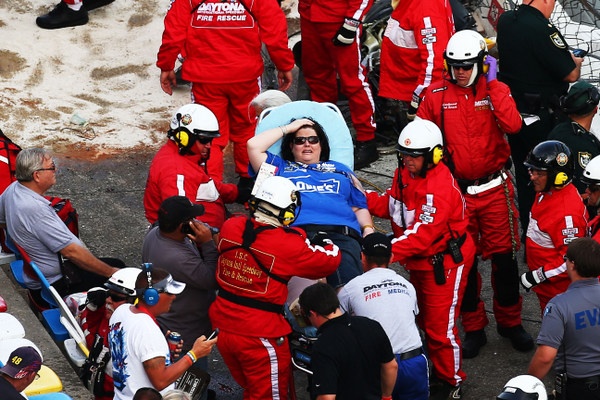
An injured fan, en route to the hospital (Photo: Getty Images for NASCAR)
By Mike Mulhern
mikemulhern.net
DAYTONA BEACH, Fla.
Lucky, lucky, lucky.
That may be the bottom line on Saturday's horrific last-lap melee that sent at least 28 fans to hospitals or care centers for treatment.
This sport and this track were very, very lucky that things weren't any worse in the crash that sent Kyle Larson airborne into the fencing, ripping down several yards of it, sending both 200-pound wheel assemblies over or through the fencing, and leaving his flaming motor -- brutally ripped out of the car -- on the wrong side of the steel safety net protecting fans.
That the situation following Saturday's crash is so difficult, so sensitive, cannot be overstated.
A race car in the grandstands could be the end of NASCAR racing as we know it. It's just that plain and simple.
No wonder there was such a solemn mood here at Daytona International Speedway in the hours before Sunday's Daytona 500.
And that was in stark contrast to the typical pre-race Daytona 500 hoopla and celebration, of bands and celebrities.
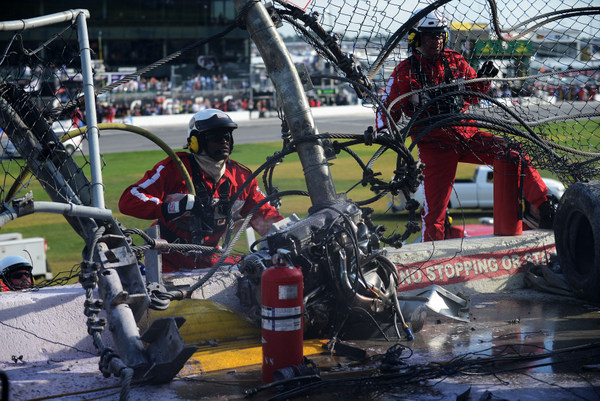
The damage (Photo: Getty Images for NASCAR)
The heavy steel fencing was repaired overnight.
Daytona track boss Joie Chitwood deferred to NASCAR for any specific assessment of the Nationwide crash and for any possible safety changes that might need to be made. He did point out that all new fencing was installed here in 2010, following Carl Edwards' frightening Talladega crash.
NASCAR's Steve O'Donnell, the sport's top competition director, declined to set any time table. But he said he was "confident" in the safety preparations for the 500. "The fans are our first priority. We want everybody to be safe. We're confident in what's in place at today's event."
NASCAR president Mike Helton has made only a brief statement on the situation, that Saturday afternoon. And NASCAR CEO Brian France has apparently made no statement yet.
O'Donnell's 10-minute Q&A, in the 500 garage amid running engines and other usual pre-race noise, was carefully followed by NASCAR PR executives ringing the crowd of journalists. And O'Donnell was cautious and careful in his every word.
The easiest solution, of course, would be to raise the grandstand seating and eliminate fan seats in that area closest to the track. Indeed the late Dale Earnhardt once suggested just such a solution to the sometimes wild and crazy crashes that can occur at Daytona and Talladega.
Just moving fans away from the danger zone.
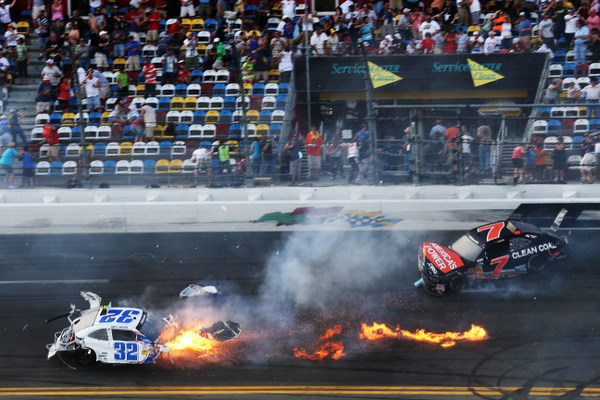
Kyle Larson (32) got a wild ride (Photo: Getty Images for NASCAR)
NASCAR has worked extensively over the years, since Bobby Allison's terrifying 1987 wreck at Talladega, on various projects to keep that from happening. Roof flaps on cars, to keep them from becoming airborne. Attention to speed, with 200 mph once an unthinkable red line. Stronger, taller fencing, reinforced with aircraft quality steel cables.
But even with all that, at least 28 fans were injured in Saturday's crash from debris flying into the stands.
And NASCAR officials realize that is just unacceptable.
Hence the clear sense of urgency here Sunday morning.
With that, however, it might seem odd that track officials have not roped off that specific danger area and barred fans from those seats for the 500.
It is unclear if any state or federal safety officials -- whoever they might be -- have been asked to look at the situation.
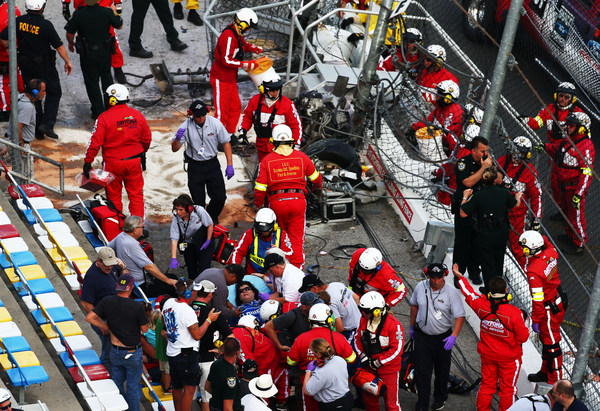
Daytona's sea of red-suited emergency workers (Photo: Getty Images for NASCAR)
Track officials again declined to speak about the condition of any of those fans, citing medical privacy rules. But Chitwood did say that some of the 14 fans admitted to nearby hospitals had been released. And Chitwood said the track provided personal assistance to each of the families involved, to keep family members in touch with their injured.
Obviously some things didn't go right. Flaming engines aren't supposed to be flung into the grandstands, nor giant race tires.
But on the plus side, Daytona's emergency crews and emergency procedures worked seemingly fine. Dozens of EMTs were at the scene quickly.
"Every January we bring the best and brightest emergency workers together to train," O'Donnell said. "Reaction from our medical and safety personnel was very good."
O'Donnell says "we'll bring in the best and the brightest" to study what happened. "The process has started."
While Larson's car was badly damaged, the front completely ripped off and the back banged up, O'Donnell said "for the most part the car held up."
Indeed Larson climbed relatively unscathed.
With the wheels torn off, there is question about that part of the car. O'Donnell though pointed out the 'tethers,' designed to hold the wheel assembly together, "held up." Unfortunately the entire assembly was torn from the frame.
"The challenge is that (wheel) piece obviously got away when it hit the fence. We can learn. Now we've got to take another look and say...'is there more we can do?'"
The area of the fencing where the incident occurred includes a cross-over gate, and there has been speculation might be somehow part of the issue.
"We've got to evaluate that," O'Donnell said.
O'Donnell said he couldn't give a precise timeline of events once Larson's car got airborne. "We're still reviewing the film."
Another issue, which has been raised many times before, is whether NASCAR should somehow penalize drivers for blocking. It was a block that triggered the crash.
O'Donnell was noncommittal about that, except to say the sanctioning body analyzes every race.
Another long-running issue is whether this track is just outdated and needs to redesigned. It was built in the 1950s, and the pole for the first Daytona 500 in 1959 was only 140 mph. The pole for this race was 196 mph. (The track record is 210 mph.)
The France family, which owns this track, has long dismissed that question.
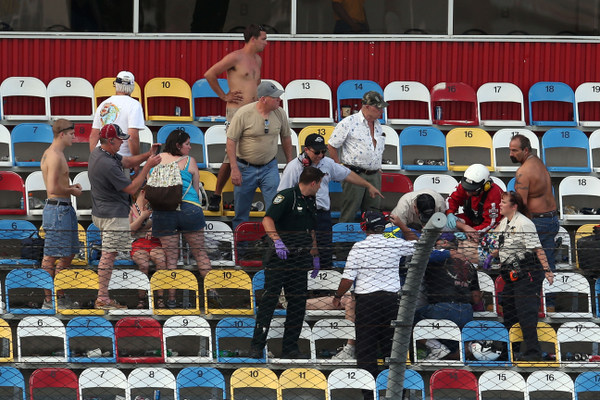
One of Larson's wheel assemblies flew this high up into the stands....and that's not good. (Photo: Getty Images for NASCAR)
© 2010-2011 www.mikemulhern.net All rights reserved.
Web site by www.webdesigncarolinas.com







Problems Without Solutions?
The bigger question may be whether the problems simply don't have solutions. Spectator injuries are by no means limited to the biggest superspeedways (having myself witnessed a crash at Thompson Speedway in 2001 that injured several spectators); this Kyle Larson melee is simply the most immediate and most surprising. The sport has seen close calls such as Keselowski's flight at Atlanta in 2010 and debris bouncing toward the fencing or over it is more common than one might think.
The one question I have about the fencing is why it snagged the engine and wheels of Larson's car - it seems that's why the car ripped open, because the fencing or crossover gate snagged the engine itself and wouldn't allow the car to continue on.
The idea that the track may be outdated or that seating needs to be moved back is asking the wrong question - is the performance level of the racecars outdated? The NFL's head injury issues are really an issue familiar to racing - competitor performance levels that are simply too great for safety as well as quality competition. NASCAR already knows from wind tunnel testing years back that 194 is the cut-off point for keeping the cars on the ground, and in the draft the cars are hitting trap speeds of 200 and above.
Why restricting the cars more so 190 cannot be reached in the draft hasn't been brought up is puzzling, because adding more restriction to the speed is fairly easy to do. We already know (via both the eye test and G-readings) the other tracks in the sport register harder crashes than Daytona and Talladega, and it long ago should have been clear the sport does not need the performance levels of the racecars it presently has.
Until you mentioned it, maybe it might take the
Until you mentioned it, maybe it might take the Feds (I doubt ANY of the Southern States Govts to move on this issue) to do something. I think it's really come down to the science of speed vs mass vs car's impact/accident/disintegration. Unfortunately, the fans are at risk as well. Even if it's a freak accident like Dale Earnhardt's roof flying into the grandstands in T2 at Daytona years ago or Kevin Harvick's wheel flying off into the infield at Charlotte. You always have to stay mindful and alert at all times. Great story.
Post new comment